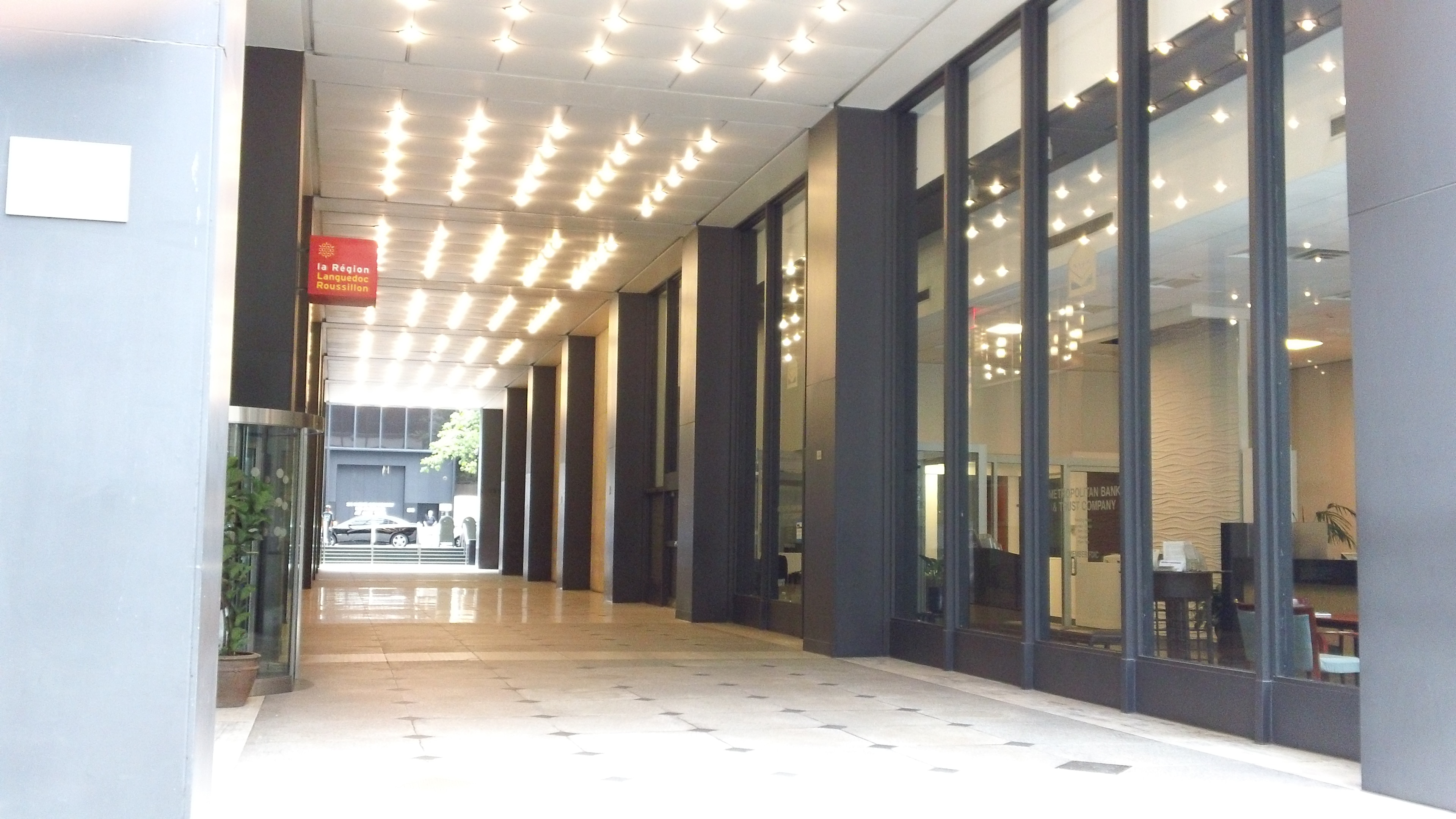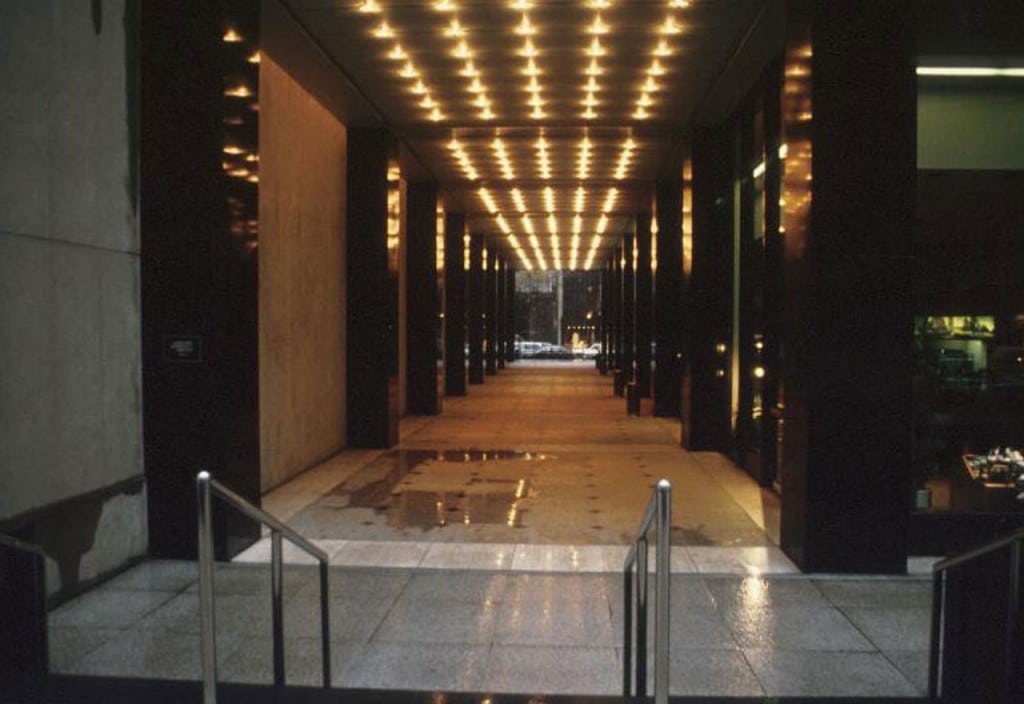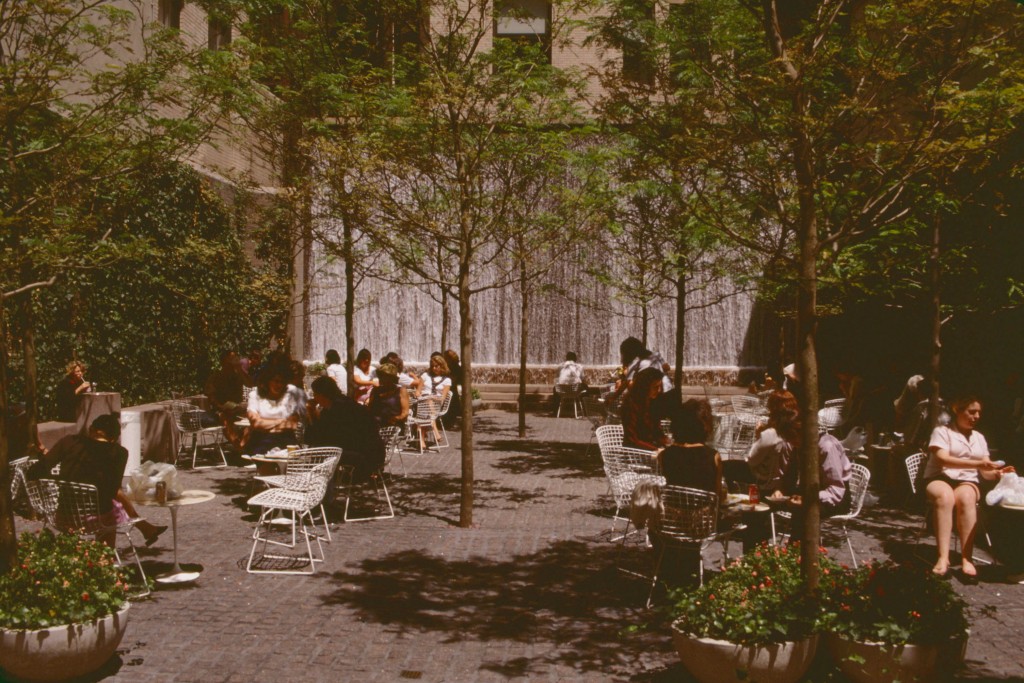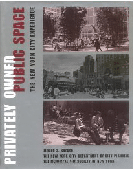
10 East 53rd Street
HarperCollins
Several steps east of Fifth Avenue and running parallel between East 52nd and 53rd Streets, the HarperCollins through block arcade distinguishes itself as much for what it connects as for what it is. Facing the arcade across East 53rd Street is Paley Park, one of the city’s treasured privately owned private spaces, open to the public through the goodwill of its owner. South across East 52nd Street is the entrance to Olympic Tower’s through-block covered pedestrian space. Together, the HarperCollins and Olympic Tower public spaces forge a two-block protected passageway making possible a direct pilgrimage between Saint Patrick’s Cathedral and Paley Park.

As for the through block arcade itself, it serves its purpose of pedestrian connection well. At East 53rd Street, a black cylindrical totem announces a beginning or terminus. Unenclosed at both ends, the two-story corridor is designed for movement, with capacious width, few retail distractions, and no obstructions. Like milestones, black rectangular columns on white stone walls rhythmically mark the journey’s progress. Long rows of theatrical lighting above gently guide users north or south and generate necessary illumination. Small plaza spaces occupy the building’s setbacks at both East 52nd and 53rd Street entrances and provide planters with evergreen bushes and, on East 52nd Street, a sittable ledge.
Because Paley Park is not a legally required privately owned public space, as that term is used in this book, it lacks its own profile. Its proximity to the HarperCollins space, however, provides a geographical hook, if not a convenient excuse, to remedy that exclusion. Designed by the noted landscape architectural firm of Zion & Breen and named for Samuel Paley by his son, the CBS executive William Paley who created the space, Paley Park opened on May 23, 1967, and has since become a model for how philanthropy and design can produce a peerless public space.
The 4,200-square-foot park (roughly 42 feet by 100 feet) eases its rectangular geometry through a sublime blend of natural and synthetic materials, textures, colors, and sounds. The park notifies passersby of its presence through strategic placement of trees, planters filled with brightly colored flowers, and special paving on the sidewalk. Up four steps through a narrowed entrance is ordered nature, a modernist landscape. As a stand-alone space unconnected to a bonused building and the stream of workers or residents in and out—a vest-pocket park without the suit– the space can focus on its singular mission of serenity, contemplation, and renewal.
The ground is paved not with terrazzo or concrete, but with rough-hewn stone tiles. The 17 trees, spaced at 12-foot intervals, grow out of the surface and are tall enough that their understory sustains an open air feeling while their canopies block out looming skyscrapers. Planters overflow with flowers. Ivy-covered brown-brick walls protectively envelop the space and exclude winds that bedevil so many plazas. Scattered generously throughout are movable Bertoia wire-mesh chairs (“Bird Chair,” by Harry Bertoia, 1950-1952) and movable tables. A food kiosk at the southeast corner gatehouse sells light refreshment, while the gatehouse at the southwest corner shelters mechanical equipment for park maintenance activities.
At back is the wondrous and accessible rock-faced 20-foot waterfall. If Paley Park’s visual cues have not removed the intensity of the city, then the whooshing water noise and spray will complete the job. Water does not trickle down, it pours down, hits a level, and then pours down some more into a pool. According to the park superintendent, a 50-horsepower pump pushes a recirculated 1,800 gallons per minute uphill for its downward journey. Only in January is the waterfall drained and turned off. Otherwise, on cold days, the water is heated by a steam turbine before it is pumped.

Paley Park’s quality is confirmed by its unusual quantity and mix of users. In addition to the regulars who work or live nearby are the accidental or intentional tourists. On any given day, the roster might include random visitors from New Jersey or Japan as well as landscape architects and designers making the educational journey. At last check, the space maintained hours from 8:00 a.m. to 10:00 p.m., May 1 through November 1, and from 8:00 a.m. to 8:00 p.m., November 2 through April 30.
Is there a lesson here? The subtext of the plaque near the entrance subtly implies one: “This park is set aside in memory of Samuel Paley, 1875-1963, for the enjoyment of the public.” No sign announces that the space is required by law to be open to the public. No zoning design standards were mandated and no zoning bonus was given. Like the outdoor spaces at Rockefeller Center, the 6,360-square-foot Greenacre Park on the north side of East 51st Street between Second and Third Avenues, or the Ford Foundation building atrium on the north side of East 42nd Street between First and Second Avenues, Paley Park is a product of a private owner’s sense of civic philanthropy, interest in urban design, and understanding of wise stewardship. Paley took high-value land that would normally accommodate a revenue-earning building and made way for a park. He hired a top landscape architect, Robert Zion, who had for years promoted the idea of “parklets” substantially smaller than the City Parks Department’s then prevailing notion that three acres was the minimum acceptable park size, to design the space. He and his wife created and funded the position of a full-time park superintendent and associated maintenance personnel. According to one of the recent superintendents, the two visited the space regularly, and Mrs. Paley’s morning stop included instructions about which flowers to plant each month. In short, zoning incentives and legal requirements are helpful, but not always sufficient, for the task of creating excellence in public spaces.
Paley Park’s influence extends well beyond its borders. In New York City and elsewhere around the country, many urban outdoor spaces borrow design features from the park. Some New York spaces have substantially modeled themselves on Paley Park, including, for example, the nearby spaces at 520 Madison Avenue and 535 Madison Avenue, and the park at One East River Place.


